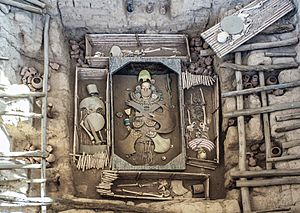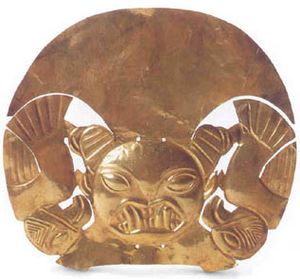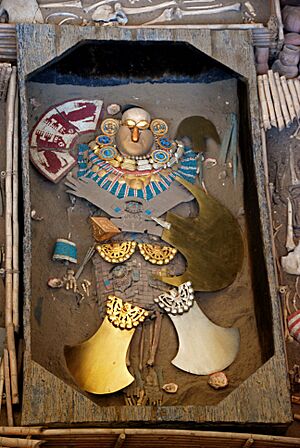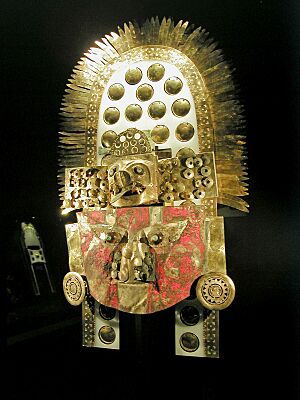Huaca Rajada facts for kids
Huaca Rajada, also known as Sipán, is an important Moche archaeological site in northern Peru. It's located in the Lambayeque Valley. This site is famous because of the amazing tomb of the Lord of Sipán, which was discovered by archaeologists Walter Alva and his wife Susana Meneses starting in 1987. The ancient city of Sipán existed from about 50 AD to 700 AD, during the same time as the Moche Period.
Contents
Why is Sipán Important?
Sipán is an archaeological site where royal tombs were found and carefully dug up between 1987 and 1990. This was a fairly recent discovery, and it's considered one of the most important archaeological finds in the last 30 years. Sadly, many of the tombs had been robbed before archaeologists arrived. However, the artifacts that remained and were discovered by the archaeologists have helped us learn a lot about the Moche rulers and their traditions.
The tombs at Sipán are made of adobe (sun-dried brick) and are shaped like pyramids. Over time, these structures have worn away, possibly made worse by strong El Niño weather events. We don't know much about the everyday people of Sipán. However, we do know that commoners often paid a tax by working. This labor helped build the large burial platforms for the Lords of Sipán. These platforms and other adobe buildings often have special marks on their bricks, which helped track this labor for tax payments.
The tombs of Sipán also helped archaeologists understand the "Sacrifice Ceremony" of the Sipán rulers. This ceremony was often shown in ancient paintings, on pottery, and other decorated items. These pictures often showed prisoners with gods or royalty. When archaeologists found artifacts in the Sipán tombs, like special decorations, headdresses, large knives, and tools, they realized that the rulers actually took part in these ceremonies.
Protecting Sipán from Looters
In February 1987, a group of tomb robbers, called huaqueros, dug a tunnel into one of the pyramids at Huaca Rajada. Over a few nights, they stole many valuable metal objects. They also destroyed hundreds of ancient pottery pieces and human remains. Countless artifacts were lost forever, sold illegally to private collectors.
Archaeologist Walter Alva arrived with the police a day or two later. This happened after a very fancy mask was taken from the robbers' hiding place and shown to him. There are different stories about what happened when Alva and the police arrived. But it's clear they managed to chase the robbers away from the site. They then put up fences around the tombs and started their own careful digging.
After this, Alva and his team uncovered 12 more tombs. During this time, villagers and robbers sometimes threw rocks and shouted at the researchers. They wanted the archaeologists to leave so the looting could continue. But the archaeologists did not give up. Alva finished his important work, which became the basis for the "Royal Tombs of Sipán" discoveries.
Amazing Moche Metalwork
During the excavations from 1987 to 1990, archaeologists found an amazing collection of gold and silver ornaments and ceremonial objects. These items date back to between 50 AD and 300 AD. They show how incredibly skilled the Moche metalsmiths were. They used advanced techniques to create these beautiful pieces.
Moche smiths made these artifacts from thin sheets of copper alloys. They used special processes to add a very thin layer (0.5 to 2.0 micrometers) of gold or silver coating. To make the artifacts, copper was hammered into thin sheets and shaped, for example, into a mask. The exact way they added the gold is not fully known. One idea is that gold was dissolved in special liquids found in the Peruvian deserts. The copper sheet was then dipped into this warm liquid, causing the gold to stick to the copper. The sheet was then heated to a high temperature, making the gold layer permanently bond to the surface. These gold layers were not pure gold; they were often a mix of gold, copper, and silver.
Some silver artifacts, like small head-shaped beads, were made by repeatedly hammering and heating a copper-silver alloy. This process caused copper-oxide to form on the surface, which could be removed using acid from plants or a base like old urine. After many repetitions, most of the copper would be gone, making the object look like pure silver. In reality, the surface might only be about 18% silver. Other silver items were likely made in a similar way but had much more silver on their surface, sometimes up to 90%.
Examples of metalwork found at Sipán include:
- Head-shaped beads
- Peanut-shaped beads
- Coffin straps
- Fan handles
- Spearheads
- A copper-plated banner
- Ceremonial knives
- Golden headdresses
- Silver and gold nose and ear ornaments
- Scepters
- A gold necklace with 10 spiderweb beads (spiders with human faces on golden wires)
- A gilded copper animal (perhaps a fox or dog)
Most of these valuable items were placed in richly decorated tombs. This shows how important they were to the Sipán leaders. It also suggests that artisans had to keep making new artifacts because old ones were often buried with the dead.
Museums with Sipán Artifacts
Museo Tumbas Reales de Sipán
- The Museo Tumbas Reales de Sipán, or Royal Tombs of Sipán Museum, is in Lambayeque, Peru. It opened in 2002.
- This museum focuses mainly on the tomb of the Lord of Sipán, which was found in 1987.
- It also features the 8 people sacrificed with him, the Old Lord of Sipán, and a priest who accompanied the Lord.
- The museum is set up in a special way. You start on the third floor and move down to lower levels. This matches how the archaeologists dug up the tomb, layer by layer.
- The museum has a full-size copy of the Lord of Sipán's tomb. It includes exact copies of the structures and all the precious metal ornaments, jewels, pottery, wood carvings, and other items found in the tomb.
- You can find more information about the Museo Tumbas Reales de Sipán in the External Links section.
Royal Tombs of Sipán Traveling Exhibit
- The Royal Tombs of Sipán was a special exhibit that traveled across the United States from 1993 to 1995. It was organized by the Fowler Museum of Cultural History.
- The exhibit had rooms separated by where the artifacts were found. There were three main rooms for:
- Tomb 1: This was the richest tomb, belonging to the Lord of Sipán.
- Tomb 2: This tomb had fewer artifacts.
- Tomb 3: This was the oldest tomb.
- The exhibit also had a separate room for artifacts that had been recovered from looters. These items were kept separate because no one knew exactly which tomb they originally came from.
- Some artifacts on display included:
- From Tomb 1: Many earspools, large peanut-shaped beaded necklaces, 12 feather fans, detailed metal animal designs, and a mannequin wearing all the Lord of Sipán's burial clothing.
- From Tomb 2: An owl headdress made of copper and feathers, and a double necklace with one strand of smiling human faces and another of grimacing human faces.
- From Tomb 3: This was an older pit burial, but still very fancy. It had gold jewelry with human faces and spider webs. Many artifacts from this tomb were not well preserved and couldn't be displayed, but they were shown in catalogs. These included gilded animals with movable parts, wooden items, and pieces of textiles.
Sipán Tomb Reconstruction
- A reconstruction of one of the Sipán tombs is on display at the American Museum of Natural History in New York City.
Nearby Moche Locations
- Pampa Grande is about 10 kilometers (6 miles) east of Sipán, along the Chancay River valley.
- Chiclayo is about 29 kilometers (18 miles) west of Sipán.
- Lambayeque is about 40 kilometers (25 miles) west-northwest of Sipán.
- Pacatnamu is about 58 kilometers (36 miles) south of Sipán.
See also
 In Spanish: Huaca Rajada para niños
In Spanish: Huaca Rajada para niños






